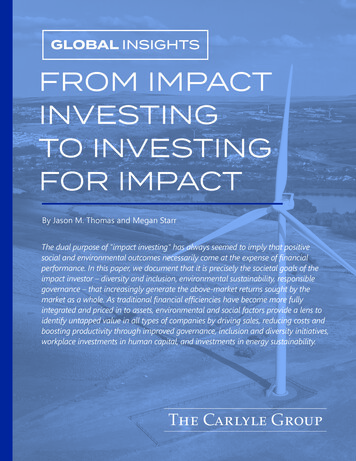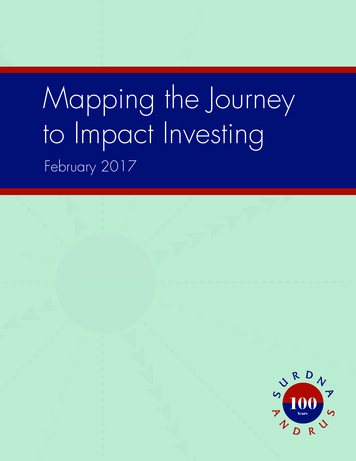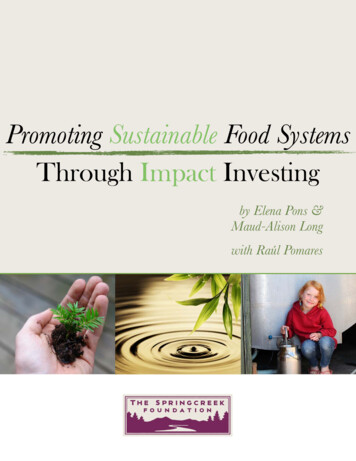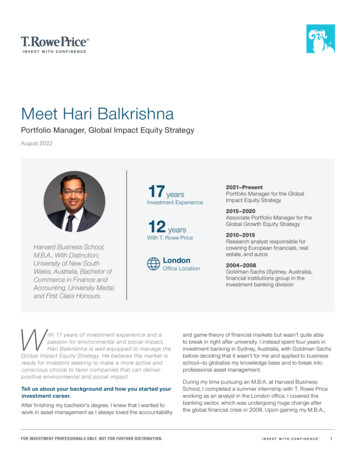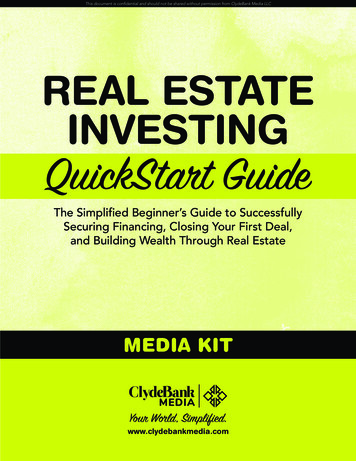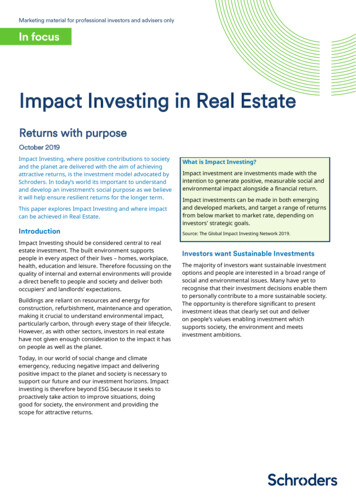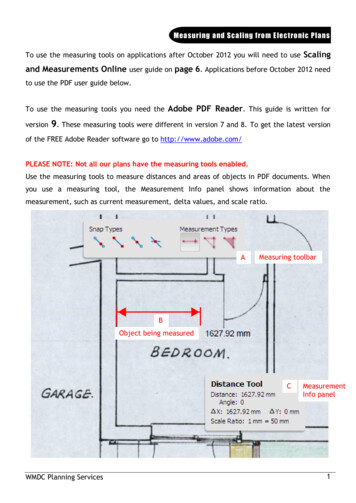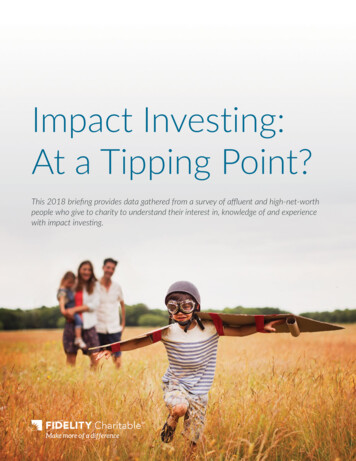
Transcription
CASE STUDYAccelerating Measurement within Impact Investing:Five Critical LessonsFebruary 2018Background and ChallengeSince its founding in 1959, the mission of the Inter-American Development Bank (IDB) has been to improve livesin Latin America and the Caribbean by addressing some of the world’s most critical challenges, such as reducingpoverty and social inequalities. Additional IDB goals include fostering development through the private sectorand promoting regional cooperation and integration.i As part of these goals, IDB launched the MultilateralInvestment Fund (MIF) in 1993. The MIF has effectively established itself as “the largest provider of technicalassistance for private-sector development,”ii partnering with 39 member countries to fund more than 2,000private sector development projects with total financial investments amounting to more than 2 billion USD.The IDB and MIF continue to look for new and improved ways to measure and track the impacts of their financialcontributions. MIF investees—the enterprises who receive funding—also want to measure their impact ineffective and resource-efficient ways. As one example, on which this case focuses, the MIF looked to improveand standardize the indicators they use to assess their inclusive distribution networks, which seek to generatebusiness opportunities for micro-entrepreneurs in low- and middle-income economies. The MIF’s lack ofstandardized indicators made it difficult to aggregate data, encourage learning across similar enterprises ordemonstrate the collective benefit of financing these organizations to outside funders. However, these concernsare not unique to MIF or its investees. Other impact investors and their investees also face many of the sameissues. This case provides key insights and solutions to address these challenges.Proposed SolutionTo address the challenge of standardizing indicators, MIF, in partnership with the Citi Foundation and Canada'sInternational Development Research Centre, created the SCALA Inclusive Distribution Network (SCALA) in2013 to promote economic growth in Base of the Pyramid communities in the region.iii In addition to providingfinancing, SCALA promotes collaborative work through “laboratories” aimed at overcoming the commonThe William Davidson Institute at the University of Michigan1
Accelerating Measurement within Impact Investing: Five Critical Lessonschallenges that its inclusive distribution member organizations face while piloting and scaling. In 2015, SCALAformed the Metrics Lab—currently led by the William Davidson Institute (WDI) at the University of Michigan—toaddress the lack of existing mechanisms for measuring and comparing socio-economic and business impacts.As part of this work, WDI reviewed and adapted six existing metrics frameworks and tools to develop theInclusive Distribution Network Measurement Framework, a new indicator framework for boosting the impactof small inclusive businesses and their distribution networks.1 WDI designed the framework to combine thestrengths of these existing frameworks while simultaneously leveraging the many indicators that enterprisesalready collected and relied on regularly. Notable features of the framework are that it (a) consists of both socioeconomic well-being and key business performance indicators, (b) organizes indicators by those that measureshort-term and long-term impact, and (c) provides guidance for indicator selection based on the enterprise’sstage of growth. Additionally, WDI mapped each framework indicator to its relevant Sustainable DevelopmentGoals (SDGs) so the pilot could provide MIF with a holistic understanding of poverty, which could track progresstowards broader development goals.Measurement enables investors and investees to be more deliberate in their use of data for course-correctionand adaptive management.iv For investors, creating a standardized set of indicators to be shared acrossenterprises is beneficial for aggregating data, using their resources efficiently and facilitating shared impactlearnings across their network of investees. Standardized data can be collectively reviewed, providing a spaceto investors and their investees to speak using a shared language and reflect on lessons learned both withinand across stakeholders. For investees, impact measurement can also expose vulnerabilities along the valuechain that affect enterprise objectivesv and facilitate better management of common business challenges, suchas turnover and client loyalty. Further, selecting indicators from a shared framework provides flexibility andlearning opportunities to the organizations needing to select context-specific indicators.viMethodsTo assess the value and challenges of embedding the framework across the SCALA network, WDI pilot tested theframework with three SCALA social enterprises in Brazil, Nicaragua and Peru. From January 2016 to May 2017,WDI conducted the pilots using a six-phase research design (see Figure 1) that resulted in developing rigorous,context-specific surveys and data collection processes for each enterprise.2 The methodology was tailored toeach pilot and included several phases which were conducted remotely, including a pretest of two of the threepilot surveys. WDI selected this approach to give the organizations flexibility in how they would engage with WDIas a monitoring and evaluation (M&E) expert, while also allowing them to conserve limited financial resources.In some cases, however, the chosen methodology put more pressure on the organization to carry out certainactivities where WDI’s in-person expertise would have proven valuable. For instance, findings from the pilotsrevealed that the organization which elected to have WDI conduct the pretest resulted in more statistically validsurvey measures (as demonstrated by Cronbach’s alpha).3 Additionally, WDI provided diligent and detailed M&Eeducation trainings through each phase to the enterprise’s leadership and senior staff members.1 Frameworks and tools referenced: Base of the Pyramid Impact Assessment Framework; Clinton Foundation Survey, which includes the PovertyProbability Index (PPI); OPHI Multidimensional Poverty Index; Poverty Spotlight; Social Progress Index, and; BSD’s 3Es Framework. Indicatorsin the framework also map to the Sustainable Development Goals.2 Each of the six phases had a specific goal. The pilots began with co-selection of context-specific indicators with enterprise management andended with a final report, which included recommendations for future impact measurement activities.3 Cronbach’s alpha measures internal consistency - It measures how well several different statements fit together to measure the same construct(e.g., the constructs of self-efficacy, or empowerment).The William Davidson Institute at the University of Michigan2
Accelerating Measurement within Impact Investing: Five Critical LessonsFigure 1: Activities conducted in the six phases of the pilots with each of the three organizationsThe organizations that participated in the pilot were: Chakipi Acceso Peru: Chakipi was a last-mile distribution venture that first provided women with salestraining and microcredit and then supplied them with products such as nutritious foods, personal careitems, pharmaceuticals, and solar lamps that they sold in their communities. Launched by the ClintonGiustra Enterprise Partnership, Chakipi partnered with women’s associations to recruit and train womenacross several rural and urban regions in Peru. This enterprise was closed in late 2017. Kiteiras: Kiteiras generates new income opportunities and empowers women in poor communities inBrazil through entrepreneurship training, healthy eating advice and life skills coaching. With support from aDanone Ecosystem Fund, Danone Brazil and Aliança Empreendedora, Kiteiras supports a micro-distributionnetwork of door-to-door saleswomen and the “madrinhas,” or godmothers, who support them.vii Supply Hope: Supply Hope, a non-profit in Nicaragua, helps families earn income through micro-franchisessuch as Mercado Fresco, which means “Fresh Market.” Supply Hope has more than 75 Mercado Fresco storeslocated in the homes of the women who own and operate them. Through these stores, women provide lowincome communities with access to affordable and quality food. In addition to providing the necessaryequipment and inventory, Supply Hope also trains operators on food handling, customer service, andmoney management.viiiThe pilots tested the following processes: indicator selection; data collection; survey development; and,data analysis. Additionally, by delivering in-person and remote trainings, WDI aimed to equip each enterprisewith the knowledge, tools and processes necessary to collect data in a manner that reduced the burden ofmonitoring, evaluation and learning on their staff and stakeholders.The William Davidson Institute at the University of Michigan3
Accelerating Measurement within Impact Investing: Five Critical LessonsChakipiSupply HopeKiteirasSelf-efficacy General Time management & planning Sales skills CommunicationSelf-efficacy General Time management & planning Sales skills Financial skillsSelf-efficacy General Time management & planning Sales skills Financial skillsEmpowerment at home Decision-making Influence on familyEmpowerment at home Decision-making Influence on familyEmpowerment at home Decision-making Influence on familyQuality of life of children Overall quality of life, health, and resourcesand supportQuality of life of children Overall quality of life and healthUse of mobile technology related to theirKiteiras activityNutrition for childrenNutrition for childrenSupport provided to childrenAspirations for children(qualitative question)Aspirations for children(qualitative question)Social network Personal ProfessionalPride For organizationPride For organization For communityPride For organizationPoverty Probability Index (PPI)Poverty Probability Index (PPI)Poverty Probability Index (PPI)Social support From Chakipi colleagues From Chakipi promoterAccess to information, goods, and services Use and access to services Satisfaction of services in barrioSocial Support From Kiteiras colleaguesGender; age; civil status; education levelDesire for registered (formal) businessTrainings received from other programsYears of sales experienceHours dedicated to enterprise (weekly)Primary source of income; Other sourcesof incomeHead of household (Yes/No)Distribution channels used to make salesHousehold size and composition(Children 0-5 years; 6-12 years; 13-18 years)Household income earnersOwnership of solar products(at household level)Prior incomeDemographic and Other IndicatorsFigure 2: Indicators selected across all three SCALA Metrics Lab pilot organizationsFindingsWDI found five valuable lessons from this work with the three pilot organizations.4 With these findings, we alsooffer relevant examples to highlight the intersectionality between this work and impact measurement in thefield of impact investing. We believe that these findings are critical given the expressed need for increasedcapacity building among impact investors and investees, and funders and grantees more broadly.ix,x,xi,xii1.Use standard indicators, not standard measuresThe pilot organizations were interested in measuring several of the same socio-economic impact indicators(see Figure 2), such as empowerment and self-efficacy.5 However, the original survey measures (i.e., theactual survey questions used to measure an indicator) needed to be adapted to the local context andwere changed dramatically via pretesting for each organization. For example, all three pilot organizationswanted to collect Poverty Probability Index (PPI) data.6 WDI found that for the questions comprising thePPI, wording, definitions and even examples required edits. Had we not modified these measures, thesurvey questions would have failed to be properly and consistently understood by the interviewees,resulting in inaccurate data collection. Therefore, WDI developed the framework so the SCALA network4 WDI recognizes the limitations of using a small sample size to produce this case study. The three organizations that participated in the pilotshare many similarities in the types of products and trainings they offer, as well as the profile of the populations they engage with. WDI believesa case study approach is the most appropriate method for sharing the findings derived from the pilots.5 Self-efficacy is one’s belief in one’s ability to succeed in specific situations or accomplish a task. For the pilots, we included survey measureswhich asked about self-efficacy related to skills such as time-management, communication, sales and finances.6 The Poverty Probability Index (PPI), previously the Progress out of Poverty Index, is an internationally recognized measurement tool whichconsists of 10 questions about a household’s characteristics and assets and has been adapted for use across many countries. The PPI tracksmicro-distributors’ changing access to information, goods and services (such as access to a refrigerator, blender, flooring, etc) as a proxy forchange in household poverty.The William Davidson Institute at the University of Michigan4
Accelerating Measurement within Impact Investing: Five Critical Lessonswould have a set of common indicators but no standard measures; thus, allowing the enterprises to use a“common language” regarding their impacts but not the same questions.2. Capacity building at the investee level is necessary, and in demandWDI found that it was critical to address the lack of M&E trained staff at each pilot organization. TheState of Measurement Practice in the SGB Sector Report (2017) highlighted the same issue: more than 50percent of the organizations surveyed did not have any staff serving in a full-time measurement role.xiiiIn only one of our three pilots did we work directly with someone in such a role. Therefore, WDI neededto carry out multiple formal educational trainings as well as a series of informal discussions in this area.The goal of these trainings was to build in-depth M&E competencies,7 in addition to general researchand data collection capabilities, among the enterprises’ leadership and staff so they could collect dataindependently without further support from external M&E experts after the pilots ended (see Figure 1).8The same need also has been said to exist in the impact investing sector, and in the space of small andgrowing businesses more generally.xiv,xv,xvi We found that each enterprise came to the pilot with differentbackgrounds and levels of M&E, research and data collection expertise. They also had different sets oftools and processes already in place. Therefore, WDI provided the enterprises with individualized supportand training material.The three pilots requested knowledge, support and guidance related to: Selection of indicators. How do you select the right indicators? Survey design. How do you create survey questions that are accurate and meaningful, i.e., reliableand valid? How do you ensure that the questions asked to the interviewee are understood as theresearcher intended? And, what survey tools can be used to help respondents with low-literacy ratesanswer questions effectively? Training staff. How do you train staff to collect data? How should staff input (new and existing) paperbased data into electronic systems? Data collection. How often should data be collected? Where should data be collected, and by whom?How many people should be surveyed? How do you establish a “baseline”? Data analysis. How do you analyze the PPI? How do you leverage social indicators to address businesschallenges? What are useful ways to visualize the data?3.Develop a Theory of Change9 as an initial step to articulate impact and decide what to measurePilot organizations with a coherent Theory of Change (ToC) were effectively able to determine whatto measure. They selected relevant indicators in less time, as compared to enterprises with a limitedunderstanding of their ToC.10 Even if their ToC11 was incomplete, those enterprises were better able toarticulate the projected pathways through which they expected change. As a result, they were able to7 M&E that is relevant, resource-efficient, rigorous, and provides trustworthy data that is collected in a respectful manner.8 Guidance on measurement-related capacity building, included: Survey development, pretest, data collection, and analysis.9 Theory of Change explains how activities, processes, and assumptions of an organization, enterprise, or program “contribute to a chain ofresults (short-term outputs, medium-term outcomes) that produce ultimate intended or actual impacts.” (BetterEvaluation)10 Some of the pilot organizations had working theories of change, while others did not. In fact, most were incomplete or still developing. Theirapproach involved an in-depth document review and targeted conversations with key staff in order to (a) fill in gaps to the theory of change and(b) select which indicators would be most appropriate for each organization.11 Some organizations find that using the words Theory of Change is too academic and cannot be digested by business-oriented leadership andinvestors; and hence they call the same document a vision map, strategy map, or some combination of program, strategy, vision, pathwayand/or map.The William Davidson Institute at the University of Michigan5
Accelerating Measurement within Impact Investing: Five Critical Lessonscreate more informed and meaningful survey measures because they were able to articulate the outcomesand impacts they wanted to create through their operations. The pilots demonstrated that they also wereless likely to fall into the trap of collecting too much data.Additionally, the organizations with a more robust ToC were able to streamline decisions on how and whento measure the selected indicators because the organization’s chain of inputs, activities, assumptionsand risks, processes and “touchpoints” with their micro-distributors and micro-franchise owners weremapped. The pilot organizations who were able to connect their indicators back to a ToC were able to helpstaff see the “big picture” of why collecting specific data (e.g., each survey question) was important andhow this data connected back to their organizational vision. Notably, similar findings on the importanceof the ToC also have been reported in the context of impact investing.xvii,xviiiNegative aspects of not having a robust ToC were revealed during the three pilots, including: Late addition of important indicators: In one pilot, we added indicators after the survey had beendrafted. The request to include two additional indicators12 required review and reorganizing of thesurvey. We found that if that particular outcome been explicitly incorporated into the organization’sToC, these indicators would not have been overlooked during selection. Selection of unnecessary or outdated indicators: During the pilots, we found that one organizationwas operating with an outdated ToC. Certain activities described in their ToC had not taken place inseveral months due to lack of funding. Even still, the organization chose indicators related to theseactivities based on the assumption that they would resume. Operating under an outdated ToC meantthat unnecessary survey questions were created and asked to the micro-distributors and needlessdata was collected.Recent evidence shows that many enterprises and impact investors are embedding the ToC into theirmeasurement practices, further highlighting the use of the ToC for results-based management.xix4.Explicitly identify opportunities for linking social outcomes with key business performanceindicators (KPIs) to strengthen the enterprise’s mission and ability to scaleWe found that the pilot organizations struggled with how to draw connections between their data onsocial and business metrics. All three organizations requested guidance in this area. Unfortunately, WDIwas unable to provide robust training on this topic due to resource and time constraints.13 Although notall enterprise managers are convinced that evaluation can be used to improve businesses because theysee it more as a checkbox to provide accountability, our pilot organizations’ leadership felt differently: “Associal businesses, we can’t make excuses about why we can’t monitor our metrics. How are we going to reallyaddress the big social issues of our time without caring deeply about what the data is telling us we need todo differently? The funding will come if we can demonstrate impact. We have all been at the place where werealized our programs were not making the impact we hoped. It takes a lot of courage to face the facts thatwe need to change our approach.”Wherever possible, WDI relied heavily on the organizations’ proposed theory of change to offer examplesand solutions for how each could specifically track and link their socio-economic and business impacts.12 Indicators: ‘quality of life of children’ and ‘nutrition for children.’13 A certain amount of guidance on analyzing and reporting on the connections between social and impact indicators was provided by WDI suchas examples on how to categorize the data.The William Davidson Institute at the University of Michigan6
Accelerating Measurement within Impact Investing: Five Critical LessonsFor example, enterprises generally understand that their ability to retain micro-distributors can beinfluenced by the impact on the health of the micro-distributors’ children. In another study, we foundthat increasing employees’ self-efficacy increased employee retention rates. In reality, however, the mostfrequently collected data are primarily outputs, not outcomes or impacts. Therefore, without a welldeveloped theory of change these efforts were mute.5.Identify a senior-level staff member to serve as a champion to help facilitate embedding of datacollection into existing business processesWDI found that it was essential to identify a champion to facilitate embedding of monitoring, evaluation,research and learning (MERL) within each organization. This finding may seem obvious. Nevertheless, it isincluded here to highlight how invaluable a champion is to conducting M&E and implementing adaptivemanagement practices in organizations. In the pilots, two of the three organizations effectively identifiedchampions; these champions were critical to (a) determining data needs, (b) understanding the goalsof the pilot, learning the M&E technical content and sharing it internally with other staff, (c) prioritizingmeasurement within the organization, (d) ensuring that roles and responsibilities were assigned to staffat various levels within the organization throughout the duration of the pilot activities, and (e) ensuringactivities moved forward in as timely a manner as possible. In cases where business managers viewed theevaluation team as a burden on their time and resources, the champion was useful to resolve these issues.Further, the existence of this champion was associated with whether the organization began using theindicators and tools we co-developed for adaptive management after the conclusion of the pilot. Whilewe acknowledge the value of champions, other factors necessary to embed MERL include shared value formeasurement across the organization, and systems such as Management Information Systems to embedMERL behaviors and data quality controls.Moving ForwardWe believe the learnings from this experience can, and should, be applied by impact investors as they seekto increase their capacity to measure impact. As such, we offer reflections on how impact investors and theirinvestees—enterprises like Chakipi, Kiteiras, and Supply Hope—can address some of the obstacles we, andothers, have observed related to capacity building for better impact measurement.Impact investors can concentrate their measurement capacity building efforts with their investees towardcreating M&E approaches that are efficiently embedded in operations. Without building M&E capacity of theirinvestees, any socio-economic data that is collected may not be relevant or accurate. By using a theory ofchange and leveraging measurement champions among senior staff, investors can navigate the complexlandscape of M&E challenges across their portfolios. Further, these champions can also share challengesand lessons learned more broadly. Our findings highlight that investors will get quality data only when theindicators and data collected are valuable to the enterprise. Impact investors should focus on creating aneffective link between social impacts and key business performance indicators. Making these connectionsexplicit will inform evidence-based decision-making for organizational sustainability and will increase thebenefit to the clients served. One route forward would be to create a standardized set of social, economic andenvironmental indicators which investors can use as the foundation for working with their investees to selectwhich indicators best measure their desired impacts.The William Davidson Institute at the University of Michigan7
Accelerating Measurement within Impact Investing: Five Critical LessonsAt the investee level, the focus should be on increasing staff capacity to collect data effectively. Organizationsshould conduct ongoing trainings with staff on how to administer surveys and input and analyze data.Enterprises need to begin envisioning how the data they collect directly relates to their theory of changeso that they can more effectively decide what impacts to measure. Additionally, WDI would like to seebusiness managers think about impacts in the short-, medium- and long-term. If they do, the businesscan act on output and near-term outcome data while keeping an eye on their contribution to longer-termoutcome and impact goals. Honest and transparent communication about how the data will be used fordecision-making should take place more frequently—both within the organization and with their investors.Building evaluation and measurement into program management should include identifying a “champion”who will explore the critical challenges and pain points that business managers face when collectingdata. Importantly, when resources are tight, this means connecting with an expert—even if remotely, aswe did for the majority of the pilots’ activities—to help guide the process of establishing monitoring andevaluation protocols within the organization.The William Davidson Institute at the University of Michigan8
Accelerating Measurement within Impact Investing: Five Critical LessonsReferencesiInter-American Development Bank. (2018). About us. Retrieved from: ericandevelopment-bank,5995.htmliiMultilateral Investment Fund. (2018). Who we are. Retrieved from: http://www.fomin.org/en-us/Home/about.aspxiiiSCALA Annual Meeting. (2016). Mexico City, Mexico.ivMudaliar, A., Pineiro, A., Bass, R., Dithrich, H. (2017) The State of Impact Measurement and Management Practice. Global Impact InvestingNetwork (GIIN). Retrieved from: https://thegiin.org/assets/2017 GIIN IMM%20Survey Web Final.pdfvSCALA Annual Meeting. (2016). Mexico City, Mexico.viMIT D-Lab Practical Impact Alliance. (2017) The Metrics Café: A Guide to Bring Funders and Grantees to the Table. Retrieved from: https://drive.google.com/file/d/1Pet 3eP54LN1x29eZEQ8jjwMOxGwST4U/viewviiKiteiras Project of Danone Ecosystem Fund. (2016). Retrieved from: one-ecosystemfund-4a73ffc26280; iiiSupply Hope. (2018). Retrieved from: http://www.supplyhope.orgixReisman, J., and Olazabal, V. (2016). Situating the Next Generation of Impact Measurement and Evaluation for Impact Investing. RockefellerFoundation. er-Dec-2016.pdfxPineiro, A. and Bass, R. (2017). Beyond Investment: The power of Capacity-building support. Global Impact Investing Network (GIIN).Retrieved from: buildingxiLosoya-Evora, B. and Edens, G. (2017). State of Measurement Practice in the SGB Sector Report. Aspen Network of DevelopmentEntrepreneurs (ANDE). Acessed via ce/resmgr/Files/The State of MeasurementPra.pdfxiiMIT D-Lab Practical Impact Alliance. (2017) The Metrics Café: A Guide to Bring Funders and Grantees to the Table. Retrieved from: https://drive.google.com/file/d/1Pet 3eP54LN1x29eZEQ8jjwMOxGwST4U/viewxiiiLosoya-Evora, B. and Edens, G. (2017). State of Measurement Practice in the SGB Sector Report. Aspen Network of DevelopmentEntrepreneurs (ANDE). Retrieved via ce/resmgr/Files/The State of MeasurementPra.pdfxivReisman, J., and Olazabal, V. (2016). Situating the Next Generation of Impact Measurement and Evaluation for Impact Investing. RockefellerFoundation. er-Dec-2016.pdfxvEdward T. Jackson. (2013). Interrogating the theory of change: evaluating impact investing where it matters most, Journal of SustainableFinance & Investment, 3:2, 95-110, DOI: 10.1080/20430795.2013.776257xviPineiro, A. and Bass, R. (2017). Beyond Investment: The power of Capacity-building support. Global Impact Investing Network (GIIN).Retrieved from: buildingxviiEdward T. Jackson. (2013). Interrogating the theory of change: evaluating impact investing where it matters most, Journal of SustainableFinance & Investment, 3:2, 95-110, DOI: 10.1080/20430795.2013.776257xviiiAdams, T. (2018). Social Impact Analysis: How to know if your work is making
activities where WDI's in-person expertise would have proven valuable. For instance, findings from the pilots revealed that the organization which elected to have WDI conduct the pretest resulted in more statistically valid survey measures (as demonstrated by Cronbach's alpha). 3 Additionally, WDI provided diligent and detailed M&E
